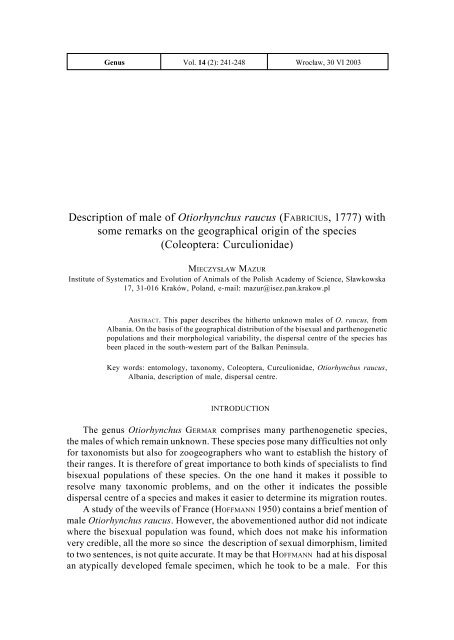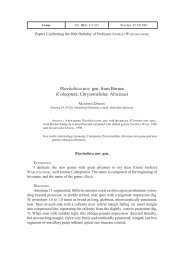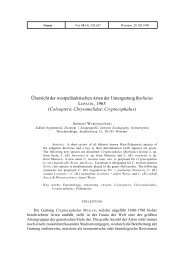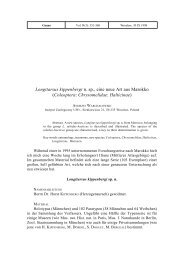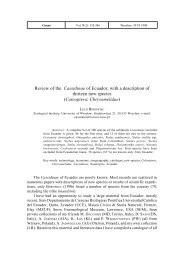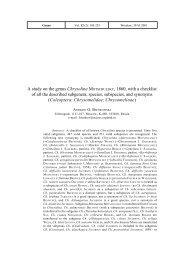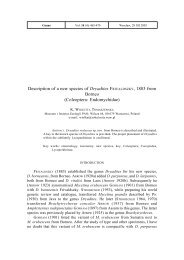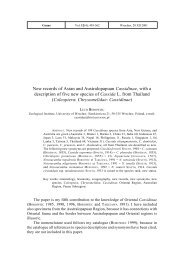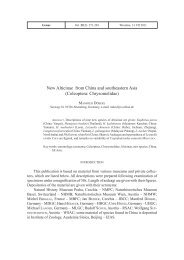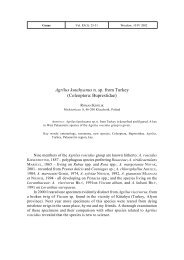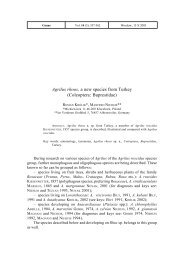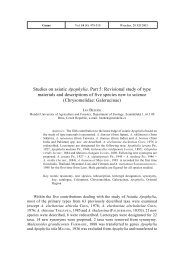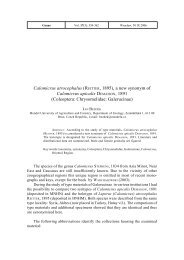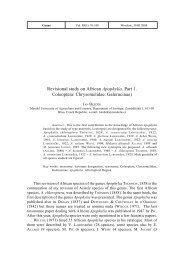Description of male of Otiorhynchus raucus (FABRICIUS, 1777) with ...
Description of male of Otiorhynchus raucus (FABRICIUS, 1777) with ...
Description of male of Otiorhynchus raucus (FABRICIUS, 1777) with ...
You also want an ePaper? Increase the reach of your titles
YUMPU automatically turns print PDFs into web optimized ePapers that Google loves.
Genus Vol. 14 (2): 241-248 Wroc³aw, 30 VI 2003<br />
<strong>Description</strong> <strong>of</strong> <strong>male</strong> <strong>of</strong> <strong>Otiorhynchus</strong> <strong>raucus</strong> (<strong>FABRICIUS</strong>, <strong>1777</strong>) <strong>with</strong><br />
some remarks on the geographical origin <strong>of</strong> the species<br />
(Coleoptera: Curculionidae)<br />
MIECZYS£AW MAZUR<br />
Institute <strong>of</strong> Systematics and Evolution <strong>of</strong> Animals <strong>of</strong> the Polish Academy <strong>of</strong> Science, S³awkowska<br />
17, 31-016 Kraków, Poland, e-mail: mazur@isez.pan.krakow.pl<br />
ABSTRACT. This paper describes the hitherto unknown <strong>male</strong>s <strong>of</strong> O. <strong>raucus</strong>, from<br />
Albania. On the basis <strong>of</strong> the geographical distribution <strong>of</strong> the bisexual and parthenogenetic<br />
populations and their morphological variability, the dispersal centre <strong>of</strong> the species has<br />
been placed in the south-western part <strong>of</strong> the Balkan Peninsula.<br />
Key words: entomology, taxonomy, Coleoptera, Curculionidae, <strong>Otiorhynchus</strong> <strong>raucus</strong>,<br />
Albania, description <strong>of</strong> <strong>male</strong>, dispersal centre.<br />
INTRODUCTION<br />
The genus <strong>Otiorhynchus</strong> GERMAR comprises many parthenogenetic species,<br />
the <strong>male</strong>s <strong>of</strong> which remain unknown. These species pose many difficulties not only<br />
for taxonomists but also for zoogeographers who want to establish the history <strong>of</strong><br />
their ranges. It is therefore <strong>of</strong> great importance to both kinds <strong>of</strong> specialists to find<br />
bisexual populations <strong>of</strong> these species. On the one hand it makes it possible to<br />
resolve many taxonomic problems, and on the other it indicates the possible<br />
dispersal centre <strong>of</strong> a species and makes it easier to determine its migration routes.<br />
A study <strong>of</strong> the weevils <strong>of</strong> France (HOFFMANN 1950) contains a brief mention <strong>of</strong><br />
<strong>male</strong> <strong>Otiorhynchus</strong> <strong>raucus</strong>. However, the abovementioned author did not indicate<br />
where the bisexual population was found, which does not make his information<br />
very credible, all the more so since the description <strong>of</strong> sexual dimorphism, limited<br />
to two sentences, is not quite accurate. It may be that HOFFMANN had at his disposal<br />
an atypically developed fe<strong>male</strong> specimen, which he took to be a <strong>male</strong>. For this
242 MIECZYS£AW MAZUR<br />
reason I have decided to describe the differences between the sexes which I<br />
observed in the investigated material from Albania. The finds <strong>of</strong> <strong>male</strong> O. <strong>raucus</strong><br />
also allow me to propose a hypothesis concerning some aspects <strong>of</strong> the development<br />
<strong>of</strong> the range <strong>of</strong> this species.<br />
Two subspecies have hitherto been distinguished <strong>with</strong>in O. <strong>raucus</strong>: <strong>raucus</strong><br />
<strong>raucus</strong> (F.) and <strong>raucus</strong> silvicola MAZUR. The former occurs mainly in lowlands<br />
and is widely distributed (the greater part <strong>of</strong> Europe, western Kazakhstan), while<br />
the range <strong>of</strong> the latter is limited to a couple <strong>of</strong> mountain ranges <strong>of</strong> the Balkan<br />
Peninsula (MAZUR 1993).<br />
In this paper, a few new terms are used to describe certain morphological<br />
features Their detailed characterisation is the subject <strong>of</strong> a separate paper (Mazur,<br />
in print). At this point only a brief explanation <strong>of</strong> these terms is presented in the<br />
form <strong>of</strong> a glossary, which will make the descriptions below fully comprehensible.<br />
Coxal area - sides <strong>of</strong> pronotum above the forecoxa.<br />
Cranium – head (caput) + rostrum.<br />
Discal area – upper surface <strong>of</strong> pronotum.<br />
Dorsal area – upper surface <strong>of</strong> elytra.<br />
Epistomal area – the frontal, dorsal part <strong>of</strong> the procranium; usually clearly demarcated<br />
from the rest <strong>of</strong> the procranium (Fig. 2).<br />
Epistomal processes – cuticular processes or just the thickenings in the frontal<br />
corners <strong>of</strong> the epistomal area in the <strong>male</strong>s <strong>of</strong> some species (Fig. 1).<br />
Mesocranium – middle part <strong>of</strong> the cranium or the basal part <strong>of</strong> the rostrum (Fig. 2).<br />
Metacranium – posterior part <strong>of</strong> cranium, ie. the head sensu stricto (Fig. 2).<br />
Procranium – anterior part <strong>of</strong> cranium which is also the anterior part <strong>of</strong> the rostrum<br />
(Fig. 2).<br />
Sternal depression – depression <strong>of</strong> the first abdominal sternite in the <strong>male</strong>s <strong>of</strong> some<br />
species.<br />
Subfrontal area – dorsal part <strong>of</strong> mesocranium, usually limited laterally by margins<br />
(Fig. 1).<br />
DESCRIPTION OF MALES<br />
Material examined: Albania (Mirditë, “Bulschari”), 2 <strong>male</strong>s in V. Apfelbeck«s<br />
collection (Institute<strong>of</strong> Systematics and Evolution <strong>of</strong> Animals, Polish Academy <strong>of</strong><br />
Science, Krakow).<br />
Body length (<strong>with</strong>out rostrum): 6.2-6.5 mm.<br />
Pigmentation: cuticle brown to dark brown.<br />
Vestiture: elytra densely squamose; scales elongate, light (grey-yellow) and<br />
dark (grey-brown), <strong>with</strong> faint metallic sheen; lighter-coloured scales maculate;<br />
maculae fine, numerous, especially in the posterior portion <strong>of</strong> elytra; pronotum<br />
<strong>with</strong> recumbent hairs and scales; the latter elongate, hair-like, maculate.<br />
Head (Fig. 1): rostrum isodiametric; procranium about as wide as metacranium<br />
at eye level; epistomal area <strong>of</strong> rostrum <strong>with</strong> two small but distinct epistomal
DESCRIPTION OF MALE OF OTIORHYNCHUS RAUCUS<br />
243<br />
processes; subfrontal area flat, parallel-sided; its lateral margin slightly elevated,<br />
bluntly carinate over entire length; procranium 1.6x wider than apical part <strong>of</strong><br />
mesocranium; eyes oval, weakly convex, not prominent in dorsal view.<br />
Pronotum (Fig. 8-9): ca. 1.2-1.4x wider than long, regularly rounded at sides;<br />
discal area <strong>with</strong> dense crater-like granules and short median carina; coxal area<br />
<strong>with</strong> large scrobicular punctures and granulate interspaces.<br />
1-4. <strong>Otiorhynchus</strong> <strong>raucus</strong>: 1 – <strong>male</strong> head, 2 – fe<strong>male</strong> head, 3 – <strong>male</strong> foretibia, 4 – fe<strong>male</strong> foretibia.<br />
Legend to abbreviations: EA – epistomal area, EP – epistomal process, Ms – mesocranium, Mt –<br />
metacranium, Pr – procranium, SA – subfrontal area
244 MIECZYS£AW MAZUR<br />
Elytra (Fig. 5): 1.23-1.28x longer than wide, oval, flattened at base, smoothly<br />
declivous towards pronotum, <strong>with</strong> basal margin not raised; posterior declivity not<br />
elevated along the suture (as in O. <strong>raucus</strong> silvicola MAZUR); humeri widely<br />
rounded; striae in dorsal area <strong>with</strong> large rotund scrobicular punctures decreasing<br />
gradually to elytral apex; intervals distinctly wider than the striae, weakly convex<br />
on disc, and entirely flat at elytral sides.<br />
Antennae: scape straight, thickened apically; funicular segments 1 and 2 equal<br />
in length, each one ca. 2.2x longer than wide; antennal club spindle-shaped,<br />
slightly shorter than 3 distal segments jointly.<br />
5-12. <strong>Otiorhynchus</strong> <strong>raucus</strong>: 5 – elytra <strong>of</strong> <strong>male</strong> from Albania; 6 – elytra <strong>of</strong> fe<strong>male</strong> <strong>of</strong> ssp. silvicola<br />
from Bulgaria, 7 – elytra <strong>of</strong> fe<strong>male</strong> <strong>of</strong> ssp. <strong>raucus</strong> from Poland, 8-9 – pronotum <strong>of</strong> <strong>male</strong>, 10 –<br />
pronotum <strong>of</strong> fe<strong>male</strong> <strong>of</strong> ssp. silvicola from Bulgaria, 11 – pronotum <strong>of</strong> fe<strong>male</strong> <strong>of</strong> ssp. <strong>raucus</strong> from<br />
Poland, 12 – pronotum <strong>of</strong> intermadiate form <strong>of</strong> fe<strong>male</strong> from Macedonia
DESCRIPTION OF MALE OF OTIORHYNCHUS RAUCUS<br />
245<br />
Legs (Fig. 3): femora <strong>with</strong>out teeth; outer margin <strong>of</strong> the foretibiae widely<br />
rounded at apex; their inner margin weakly bisinuate, <strong>with</strong> a few spine-like teeth<br />
on the inner surface; inner margin <strong>of</strong> the midtibiae <strong>with</strong> distinctly finer denticulation,<br />
and the hind tibiae <strong>with</strong>out teeth; tarsomere 2 about 1.5x wider than long.<br />
13-21. <strong>Otiorhynchus</strong> <strong>raucus</strong>: 13 – median lobe <strong>of</strong> aedeagus, dorsal view, 14 – median lobe <strong>of</strong><br />
aedeagus, lateral view 15 - spiculum ventrale, intermediate form from Macedonia; 16-21 - receptaculum<br />
seminis: 16-17 - ssp. <strong>raucus</strong>, Kraków (Poland); 18 - ssp. <strong>raucus</strong>, Przemyœl (Poland); 19-20<br />
- ssp. silvicola, Èepelare (Bulgaria); 21 – intermediate form, Strumica (Macedonia)
246 MIECZYS£AW MAZUR<br />
Body underside: abdomen <strong>with</strong> sternal depression, other characters as in<br />
fe<strong>male</strong>s.<br />
Aedeagus: median lobe as in figures 13-14.<br />
On the basis <strong>of</strong> the shape and sculpture <strong>of</strong> the elytra the <strong>male</strong>s described could<br />
be considered to be <strong>raucus</strong> ssp. silvicola, but the distribution <strong>of</strong> scales on the<br />
elytra makes them resemble the nominate subspecies. Thus the subspecies designation<br />
<strong>of</strong> these <strong>male</strong>s remains an open question.<br />
The main differences between <strong>male</strong>s and parthenogenetic fe<strong>male</strong>s <strong>of</strong> both<br />
subspecies (fe<strong>male</strong>s from the bisexual populations are unknown to the author)<br />
concern minor features <strong>of</strong> the structure <strong>of</strong> different parts <strong>of</strong> the body. Fe<strong>male</strong><br />
O. <strong>raucus</strong> are characterised primarily by:<br />
1) absence <strong>of</strong> epistomal processes (Fig. 2)<br />
2) rounding <strong>of</strong> the pronotal sides (Fig. 10-12)<br />
3) sculpture in the coxal area <strong>of</strong> pronotum (large and shallow punctures transforming<br />
in places into scrobes; interspaces <strong>with</strong>out conspicuous granules)<br />
4) shape <strong>of</strong> the foretibiae (their inner margin subrectangularly curved inwards –<br />
Fig. 4)<br />
5) absence <strong>of</strong> the sternal depression.<br />
Fig. 15 presents the shape <strong>of</strong> the spiculum ventrale, that <strong>of</strong> the receptaculum<br />
seminis being found in fig. 16-21.<br />
The abovementioned differences are generally typical <strong>of</strong> sexual dimorphism<br />
in the genus <strong>Otiorhynchus</strong>, except for the sculpture <strong>of</strong> pronotal sides. This might<br />
indicate that the described <strong>male</strong>s belong to some species other than O. <strong>raucus</strong>.<br />
However, such an assumption does not seem compatible <strong>with</strong> the occurrence <strong>of</strong><br />
intermediate forms in Macedonia (3 fe<strong>male</strong>s from Strumica), in which the sculpture<br />
on the coxal area is developed similarly to that in <strong>male</strong>s, though the granules<br />
are somewhat smaller. In the fe<strong>male</strong>s mentioned the elytral declivity is elevated<br />
and swollen along the suture (like that in fe<strong>male</strong>s <strong>of</strong> the nominative subspecies).<br />
The most important difference between fe<strong>male</strong>s originating from Macedonia<br />
and <strong>male</strong>s from Albania concerns the shape <strong>of</strong> the elytral apex. I do not think these<br />
fe<strong>male</strong>s represent a bisexual form, especially since they have the same range <strong>of</strong><br />
variability <strong>of</strong> characters as do parthenogenetic forms.<br />
It is very likely that the bisexual form <strong>of</strong> O. <strong>raucus</strong> in question was previously<br />
described from northern Albania by APFELBECK (1918) under the name <strong>of</strong><br />
O. sphaerosoma. Unfortuntely, I do not know the latter species and my assumption<br />
is based on the original description which is not sufficiently detailed. The<br />
minor differences between the two descriptions may result from the variability <strong>of</strong><br />
local populations and a different style <strong>of</strong> description. According to APFELBECK, in<br />
O. sphaerosoma elytral interstriae are clearly vaulted and provided <strong>with</strong> granules.<br />
In the specimens I have examined the interstriae are completely flat and <strong>with</strong> only<br />
a few tiny, inconspicuous granules. Other features mentioned by APFELBECK are<br />
the same as in <strong>male</strong> O. <strong>raucus</strong>. It will not be possible to decide about the synonymy
DESCRIPTION OF MALE OF OTIORHYNCHUS RAUCUS<br />
247<br />
till the types <strong>of</strong> O. sphaerosoma have been examined. I do not know where these<br />
might be kept; I did not find them in the Museum <strong>of</strong> Natural History in Budapest<br />
where the greater part <strong>of</strong> APFELBECK’s collection is housed.<br />
Range (Fig. 22)<br />
The distribution <strong>of</strong> O. <strong>raucus</strong> ssp. <strong>raucus</strong> and O. <strong>raucus</strong> ssp. silvicola has<br />
already been discussed by MAZUR (1993). Their joint range comprises the greater<br />
part <strong>of</strong> Europe and Kazakhstan (not to mention Canada where the species has been<br />
introduced). In Europe it is known from the following countries: Great Britain,<br />
Norway, Sweden, Finland, Denmark, France, Germany, Czech Rep., Slovakia,<br />
Poland, Belarus, Latvia, Lithuania, Estonia, Russia, Ukraine, Switzerland, Austria,<br />
Hungary, Romania, Italy, Albania, Macedonia, Yugoslavia, Bosna and<br />
Herzegovina, Croatia and Bulgaria.<br />
CONCLUSIONS<br />
The discovery <strong>of</strong> a bisexual population throws new light on problems concerning<br />
the origin and development <strong>of</strong> the range <strong>of</strong> the species under discussion. The<br />
most important conclusions are as follows:<br />
1. Morphological variability <strong>of</strong> O. <strong>raucus</strong> is much greater than expected and<br />
concerns a variety <strong>of</strong> features used in the systematics <strong>of</strong> the genus <strong>Otiorhynchus</strong>,<br />
especially body sculpture.<br />
22. Distribution <strong>of</strong> <strong>Otiorhynchus</strong> <strong>raucus</strong>: 1 – limit <strong>of</strong> the range; 2 – extreme localities at the eastern<br />
range border; 3 - isolated locality in Sicily; 4 – locality <strong>with</strong>out further details; 5 – localities <strong>of</strong> the<br />
subspecies silvicola; 6 – locality <strong>of</strong> the bisexual population
248 MIECZYS£AW MAZUR<br />
2. The centre <strong>of</strong> the maximum morphological variability <strong>of</strong> the species lies in<br />
the south-western part <strong>of</strong> the Balkan Peninsula and comprises the area supporting<br />
the bisexual population.<br />
3. The locality <strong>of</strong> the bisexual form lies at the southern border <strong>of</strong> the range <strong>of</strong><br />
the species, while the remaining part <strong>of</strong> the range is inhabited by parthenogenetic<br />
forms.<br />
4. The parthenogenetic form representing the nominate subspecies (MAZUR<br />
1993) has expanded from the Balkan Peninsula in different directions and for<br />
different distances. The extreme localities <strong>of</strong> this species are in the British Isles,<br />
Scandinavia and Kazakhstan. It is striking that O. <strong>raucus</strong> has only slightly extended<br />
its range to the south and south-east. So far it has not been found in Greece<br />
and Turkey, and it is generally rare in the Mediterranean area.<br />
5. The centre <strong>of</strong> distribution (centre <strong>of</strong> species diversity) <strong>of</strong> the group<br />
<strong>Otiorhynchus</strong> <strong>raucus</strong>, to which I have assigned O. <strong>raucus</strong> (F.), O. balcanicus<br />
STRL., O. megareus REITT., O. megareoides SMRECZ., O. leutneri SMRECZ., O. arabicus<br />
MAZUR and O. weisei REITT., is in Asia Minor. Thus, the range <strong>of</strong> <strong>Otiorhynchus</strong><br />
<strong>raucus</strong> lies beyond the borders <strong>of</strong> this centre.<br />
On the basis on the above findings I am <strong>of</strong> the opinion that O. <strong>raucus</strong><br />
originates from the southern Balkan dispersal centre. Therefore its range has a<br />
similar history as that <strong>of</strong> <strong>Otiorhynchus</strong> perdix (OL.) (MAZUR 1998). Its territorial<br />
success can be safely assumed to result from parthenogenesis. Man has probably<br />
played an important role in shaping this range as indicated by the fact that O.<br />
<strong>raucus</strong> is a common component <strong>of</strong> the faunas <strong>of</strong> anthropogenic habitats and its<br />
numerous populations may be found in such places as urban parks, gardens, and<br />
roadside verges.<br />
REFERENCES<br />
APFELBECK, V., 1918. Weitere Diagnosen neuer Koleopteren von der Balkanhalbinsel. Anz. kaiserl.<br />
Akad. Wiss. Wien, 55: 100-104.<br />
HOFFMANN, A., 1950. Coleoptères Curculionides I. Faune de France, Paris, 486 pp.<br />
MAZUR, M., 1993. Subspezifische Gliederung des <strong>Otiorhynchus</strong> <strong>raucus</strong> (<strong>FABRICIUS</strong>, <strong>1777</strong>) (Coleoptera,<br />
Curculionidae). Acta zool. cracov., 35: 497-507.<br />
—, 1998. Systematik und geographische Verbreitung der <strong>Otiorhynchus</strong> perdix-Gruppe (Coleoptera:<br />
Curculionidae). Entom. Problems, 29: 27-68.


